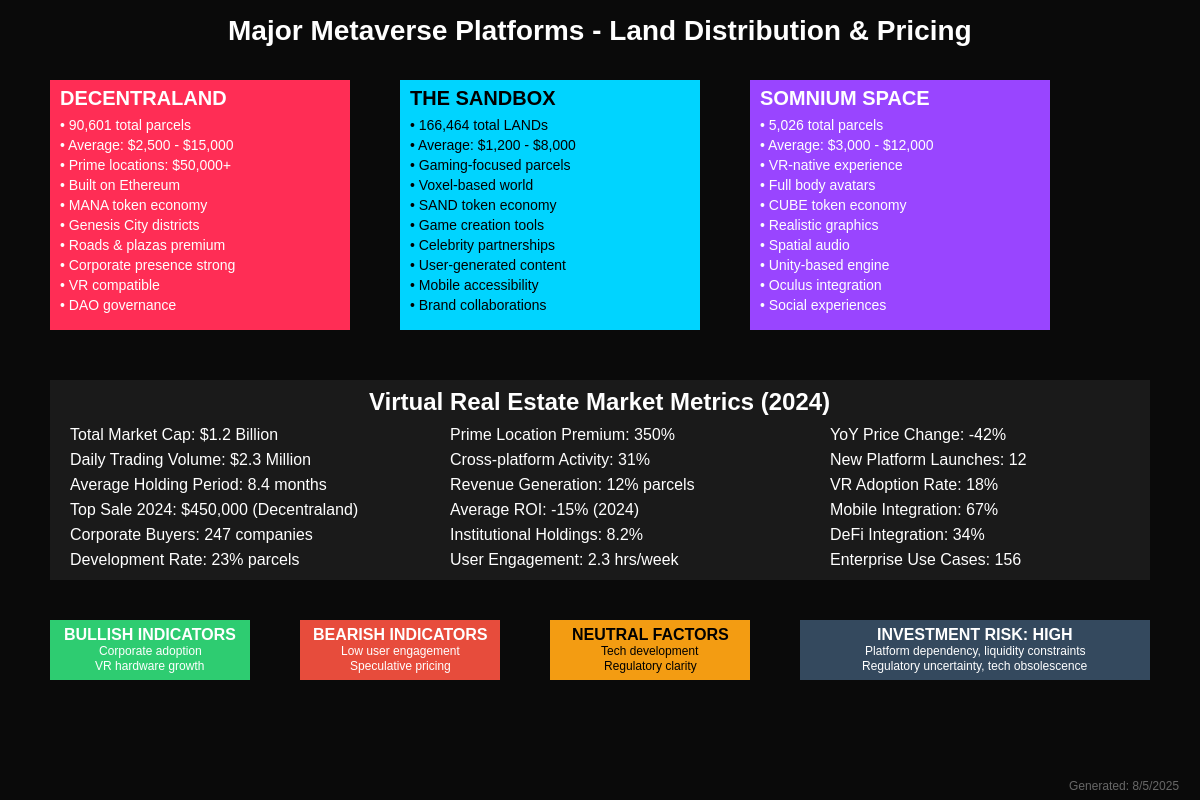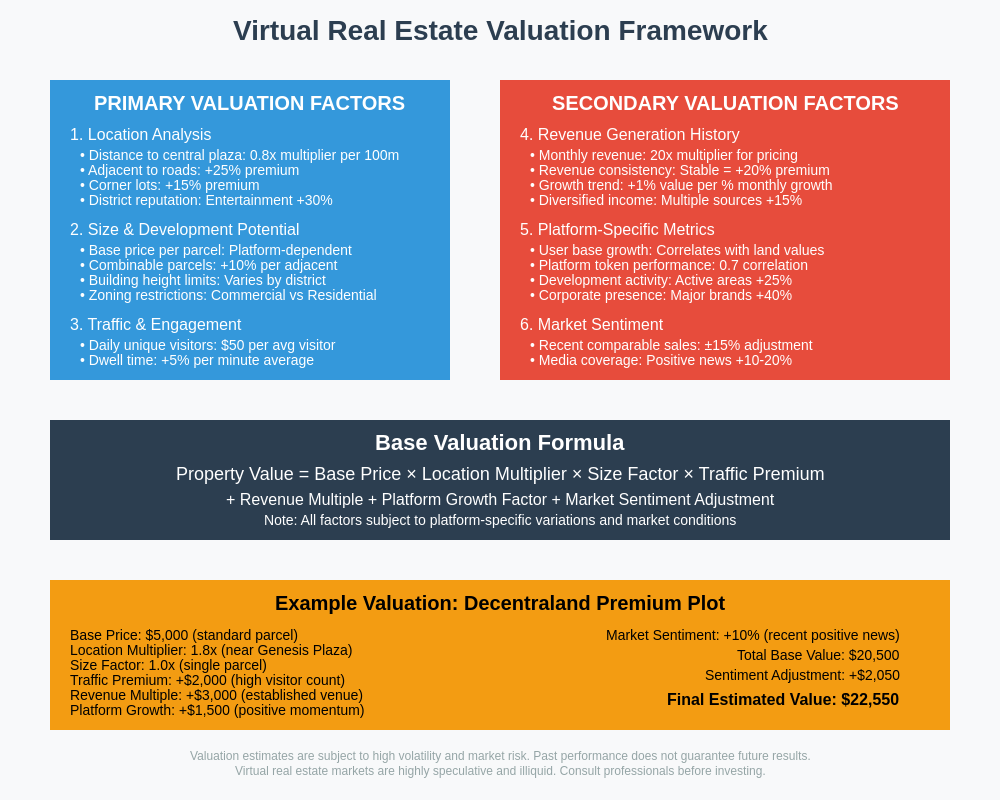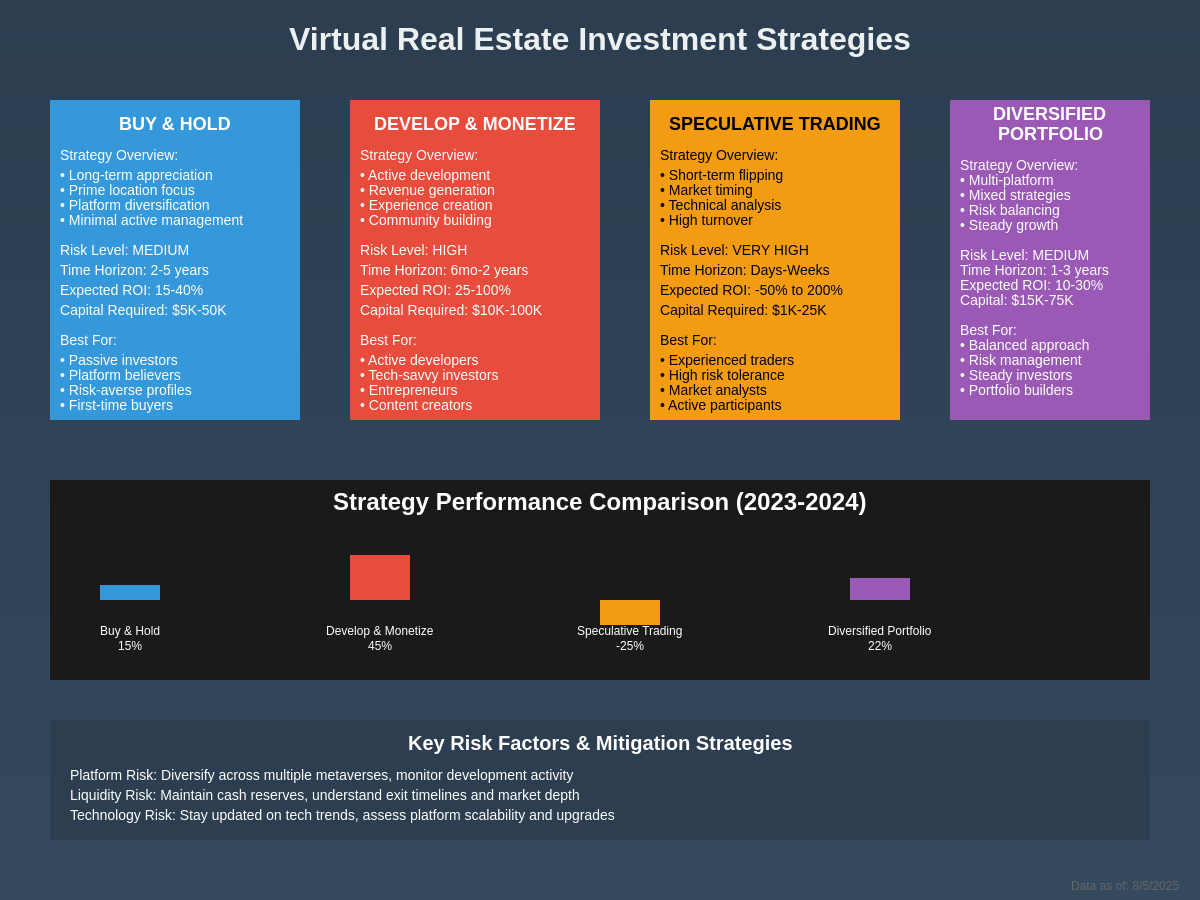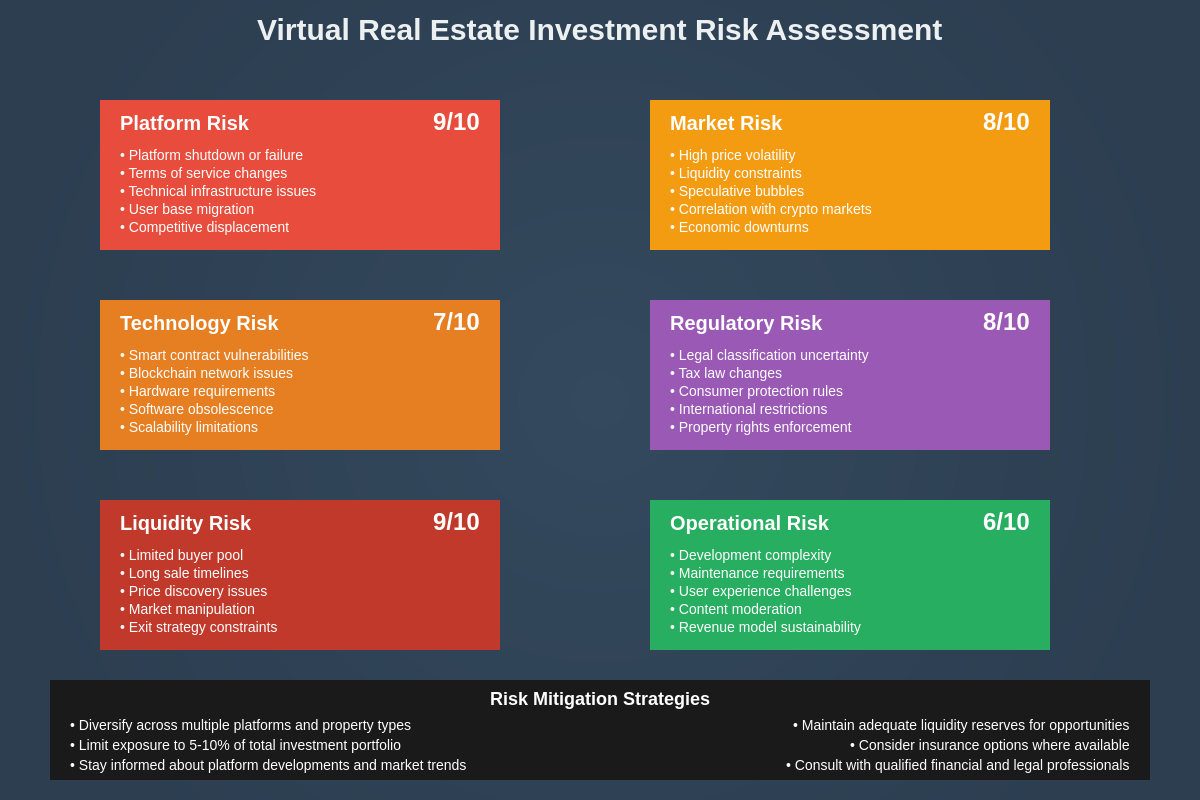Explore real-time metaverse land values and market data on TradingView
The Digital Land Rush Revolution
The concept of virtual real estate has transformed from science fiction fantasy into a multi-billion dollar investment market that is reshaping how we perceive property ownership, digital assets, and the fundamental nature of real estate itself. Virtual land NFTs represent parcels of digital space within metaverse platforms where users can build, develop, monetize, and trade virtual properties using blockchain technology to establish verifiable ownership and scarcity in digital environments.

The meteoric rise of virtual real estate markets has created unprecedented opportunities for investors, developers, and entrepreneurs who recognize the potential of digital spaces to generate substantial returns through various monetization strategies including virtual commerce, entertainment venues, digital advertising, and social experiences. Major corporations, celebrities, and institutional investors have begun acquiring significant virtual land holdings as they position themselves for what many consider the next evolution of internet interaction and digital commerce.
The fundamental value proposition of virtual real estate stems from its combination of digital scarcity, utility within growing metaverse ecosystems, and the potential for development and monetization through various virtual economy activities. Unlike traditional real estate, virtual properties offer unique advantages including instant global accessibility, infinite architectural possibilities, and integration with emerging technologies such as virtual reality, augmented reality, and artificial intelligence.
Understanding Metaverse Platforms and Ecosystems
The metaverse landscape consists of multiple competing platforms, each offering distinct virtual worlds with unique characteristics, user bases, economic models, and technological capabilities that significantly impact the value and investment potential of virtual real estate within these ecosystems. Leading platforms including Decentraland, The Sandbox, Somnium Space, Cryptovoxels, and emerging competitors have established different approaches to virtual world design, governance, and economic integration.
Decentraland operates as one of the most established virtual worlds built on the Ethereum blockchain, featuring a finite supply of 90,601 land parcels organized into districts with different themes and purposes. The platform employs its native MANA token for transactions while enabling complex virtual experiences including art galleries, casinos, conference centers, and retail spaces that generate revenue for land owners through various monetization mechanisms.
The Sandbox represents another major metaverse platform that emphasizes user-generated content creation and gaming experiences, utilizing SAND tokens as the primary currency while providing comprehensive tools for creating, building, and monetizing virtual experiences. The platform’s voxel-based aesthetic and focus on gaming elements attract a different demographic compared to other metaverse platforms, creating unique investment dynamics and market opportunities.
Somnium Space offers a more realistic virtual environment with support for virtual reality hardware, creating immersive experiences that bridge the gap between digital and physical reality through advanced graphics, spatial audio, and haptic feedback integration. The platform’s focus on VR compatibility positions it uniquely within the metaverse ecosystem as VR adoption continues to accelerate across consumer and enterprise markets.
Understanding the technological infrastructure, user adoption metrics, development roadmaps, and competitive positioning of different metaverse platforms is crucial for making informed virtual real estate investment decisions. Platform-specific factors including transaction costs, user interface quality, content creation tools, social features, and integration with external services significantly impact the long-term viability and growth potential of virtual land investments.
Virtual Land Valuation Methodologies
Determining the fair value of virtual real estate requires sophisticated analysis of multiple factors that differ significantly from traditional real estate valuation approaches, though some fundamental principles including location, utility, development potential, and market demand remain relevant in digital environments. Virtual land valuation encompasses quantitative metrics such as foot traffic analytics, adjacency to high-value properties, platform activity levels, and revenue generation potential alongside qualitative factors including aesthetic appeal, community engagement, and strategic positioning within virtual worlds.

Analyze virtual real estate market trends and pricing data
Location remains a critical factor in virtual real estate valuation, with prime locations including central districts, areas adjacent to popular venues, transportation hubs, and spaces with high visibility commanding premium prices due to increased foot traffic and commercial potential. Virtual worlds typically feature central plazas, main roads, and entertainment districts that serve as focal points for user activity, creating natural hotspots that drive value appreciation for nearby properties.
Size and development potential significantly impact virtual land values, with larger parcels offering greater flexibility for complex projects while smaller plots may be suitable for specialized applications or entry-level investments. The ability to combine adjacent parcels into larger estates creates additional value through economies of scale and enhanced development possibilities that attract institutional buyers and major brands seeking substantial virtual presence.
Revenue generation potential represents a crucial valuation component, with properties capable of hosting profitable activities including virtual events, retail operations, advertising displays, gaming experiences, and rental income commanding higher valuations than undeveloped land. Historical revenue data, traffic analytics, and comparable sales within specific platforms provide quantitative foundations for valuation models that account for the unique characteristics of virtual real estate markets.
Market sentiment, platform adoption trends, technological developments, and broader cryptocurrency market conditions significantly influence virtual land values through both direct and indirect mechanisms. The correlation between virtual real estate prices and major cryptocurrency movements reflects the speculative nature of these markets while also highlighting the importance of timing and market cycle awareness in virtual land investment strategies.
Investment Strategies and Portfolio Diversification
Successful virtual real estate investment requires strategic approaches that account for the unique characteristics of digital property markets, including higher volatility, technological risks, platform dependencies, and evolving regulatory landscapes that create both opportunities and challenges for investors seeking exposure to metaverse real estate assets. Different investment strategies cater to various risk tolerances, time horizons, and expertise levels while offering distinct advantages and limitations.

Buy-and-hold strategies appeal to investors who believe in the long-term growth potential of specific metaverse platforms and seek to acquire prime virtual real estate for extended holding periods. This approach benefits from potential appreciation in land values as platforms mature, user bases grow, and virtual economies develop more sophisticated monetization mechanisms. Long-term holders often focus on acquiring high-quality locations with strong fundamentals while accepting short-term price volatility in exchange for potential substantial returns over multi-year investment horizons.
Development and monetization strategies involve actively improving virtual properties through construction, programming, and content creation to generate ongoing revenue streams while building long-term asset value. Successful virtual real estate developers create engaging experiences that attract users, generate repeat visits, and monetize through various mechanisms including admission fees, virtual goods sales, advertising revenue, and sponsored events. This approach requires significant time investment, technical skills, and understanding of virtual world user preferences.
Portfolio diversification across multiple metaverse platforms reduces concentration risk while providing exposure to different technological approaches, user demographics, and market dynamics. Spreading investments across established platforms like Decentraland and The Sandbox while maintaining smaller positions in emerging platforms creates balanced exposure to virtual real estate markets while managing platform-specific risks including technical failures, regulatory changes, or competitive displacement.
Speculative trading strategies focus on short-term price movements and market inefficiencies to generate profits through active buying and selling of virtual land parcels. These approaches require sophisticated market analysis, timing skills, and risk management techniques while accepting higher potential losses in exchange for the possibility of rapid gains. Speculative strategies often involve identifying undervalued properties, anticipating platform announcements, or capitalizing on market sentiment shifts.
Platform-Specific Investment Considerations
Each major metaverse platform presents unique investment characteristics, risks, and opportunities that require specialized knowledge and analysis to optimize investment outcomes while managing platform-specific risks including technological limitations, competitive threats, regulatory challenges, and user adoption dynamics that vary significantly across different virtual worlds.
Decentraland investment considerations include the platform’s established position as a first-mover in blockchain-based virtual worlds, substantial corporate partnerships, and mature development tools alongside challenges including scalability limitations, user experience issues, and competition from newer platforms with advanced technology. The platform’s governance structure through the Decentraland DAO provides community control over development decisions while creating potential conflicts between different stakeholder groups.
The Sandbox offers compelling investment opportunities through its focus on gaming elements, user-generated content creation, and strategic partnerships with major brands and celebrities while facing challenges including platform complexity, content quality variability, and dependence on gaming industry trends. The platform’s emphasis on creative tools and social experiences attracts a different user base compared to other metaverse platforms, creating unique market dynamics.
Emerging platforms including Somnium Space, Cryptovoxels, and newer entrants present higher risk/reward profiles with potential for explosive growth if they achieve mainstream adoption while carrying substantial risks of failure, technological obsolescence, or competitive displacement by better-funded rivals. These platforms often offer lower entry costs and greater development flexibility while requiring careful evaluation of their long-term viability and growth potential.
Track metaverse token performance and virtual real estate correlations
Cross-platform investment strategies involve acquiring properties across multiple metaverse platforms to diversify technology risk while capturing growth opportunities in different virtual ecosystems. This approach requires understanding the unique characteristics, user bases, and development roadmaps of multiple platforms while managing the complexity of multiple wallet systems, token economies, and platform-specific rules and regulations.
Legal and Regulatory Framework
The legal status of virtual real estate NFTs exists in a complex and evolving regulatory environment where traditional property law concepts intersect with emerging digital asset regulations, intellectual property considerations, and international jurisdictional challenges that create uncertainty for investors, platforms, and users seeking clear legal frameworks for virtual property ownership and transactions.
Intellectual property rights in virtual worlds involve complex interactions between platform terms of service, user-generated content ownership, trademark protections, and copyright considerations that affect the value and transferability of virtual real estate investments. Platform operators typically retain significant control over virtual worlds while granting users limited rights that may not constitute traditional property ownership in legal terms.
Tax implications of virtual real estate transactions vary significantly across jurisdictions, with some tax authorities treating virtual land sales as capital gains while others may classify them as ordinary income or subject to different reporting requirements. The complexity of calculating cost basis, determining holding periods, and reporting transactions across multiple platforms creates compliance challenges for active virtual real estate investors.
Cross-border regulatory considerations affect international investors seeking exposure to virtual real estate markets, with different countries implementing varying approaches to digital asset regulation, foreign investment restrictions, and tax treaty applications. The global nature of metaverse platforms and the borderless character of blockchain transactions create potential conflicts between different regulatory regimes.
Consumer protection regulations increasingly impact virtual real estate markets as authorities examine whether existing securities laws, consumer protection statutes, and financial regulations apply to virtual land transactions. Platform operators face growing regulatory scrutiny regarding their marketing practices, risk disclosures, and user protection measures.
Technical Infrastructure and Security
The technical foundation underlying virtual real estate NFTs encompasses blockchain technology, smart contract systems, metadata storage, rendering engines, and network infrastructure that collectively determine the security, functionality, and long-term viability of virtual property investments while creating dependencies on various technological components that may affect asset value and accessibility.
Blockchain infrastructure security directly impacts virtual real estate investment safety, with different platforms utilizing various blockchain networks including Ethereum, Polygon, and custom solutions that offer different trade-offs between security, scalability, and transaction costs. Understanding the technical architecture and potential vulnerabilities of underlying blockchain systems is crucial for assessing investment risk and security considerations.
Smart contract risk represents a significant consideration for virtual real estate investors, as these programmable contracts govern ownership transfer, royalty payments, and platform interactions while potentially containing bugs, vulnerabilities, or design flaws that could result in loss of assets or functionality. Regular security audits, formal verification processes, and bug bounty programs help mitigate smart contract risks but cannot eliminate them entirely.
Metadata storage and permanence affect the long-term accessibility and functionality of virtual real estate NFTs, with different approaches including on-chain storage, IPFS distribution, and centralized servers offering varying levels of durability, decentralization, and cost efficiency. The risk of metadata loss or corruption could significantly impact the value and utility of virtual property investments.
Platform infrastructure dependencies create centralization risks where virtual real estate functionality depends on proprietary servers, databases, and software systems controlled by platform operators. Understanding these dependencies and evaluating platform commitments to decentralization and open-source development helps assess long-term investment viability.
Market Analysis and Investment Metrics
Virtual real estate market analysis requires specialized metrics and analytical frameworks that account for the unique characteristics of digital property markets including liquidity constraints, price discovery mechanisms, market manipulation risks, and correlation with broader cryptocurrency markets while providing insights into investment performance and market trends.
Trading volume analysis provides insights into market liquidity and investor interest across different platforms and property types, with higher volume typically indicating more efficient price discovery and easier exit opportunities for investors. Volume patterns often correlate with platform announcements, celebrity endorsements, and broader market sentiment shifts that drive speculative activity.
Price per square meter comparisons enable evaluation of relative value across different platforms and locations while accounting for the varying sizes and characteristics of virtual land parcels. These metrics help identify potentially undervalued properties and market inefficiencies while providing benchmarks for investment decision-making.
Development density and utilization rates indicate the health and maturity of virtual real estate markets, with higher rates of active development and user engagement suggesting more sustainable value creation compared to purely speculative markets. These metrics help distinguish between healthy growth and speculative bubbles in virtual land markets.
Revenue multiples and yield analysis for income-generating virtual properties provide fundamental valuation metrics similar to traditional real estate investment analysis while accounting for the unique revenue streams and cost structures associated with virtual property development and operations.
Risk Management and Due Diligence
Virtual real estate investment carries unique risks that require comprehensive risk management strategies and thorough due diligence processes to protect investments while maximizing return potential in these emerging and volatile markets that combine traditional real estate concepts with cutting-edge blockchain technology and speculative digital asset dynamics.

Platform risk represents the most significant threat to virtual real estate investments, encompassing technical failures, business model changes, regulatory actions, and competitive displacement that could render virtual properties worthless or significantly impair their functionality. Diversification across multiple platforms and careful evaluation of platform fundamentals help mitigate these risks.
Technology risk includes smart contract vulnerabilities, blockchain network issues, scalability limitations, and obsolescence of underlying technical infrastructure that could affect the accessibility, security, or functionality of virtual real estate assets. Staying informed about technological developments and platform upgrade plans helps investors anticipate and prepare for technical challenges.
Liquidity risk in virtual real estate markets often exceeds that of traditional real estate due to smaller market sizes, limited buyer bases, and the specialized nature of virtual property investments. Understanding market liquidity patterns and maintaining appropriate portfolio allocation helps manage liquidity constraints.
Regulatory risk encompasses changing legal frameworks, tax implications, and government actions that could significantly impact virtual real estate markets or specific platforms. Monitoring regulatory developments and consulting with qualified professionals helps navigate the evolving legal landscape.
Monitor virtual real estate market volatility and risk metrics
Future Outlook and Emerging Trends
The future of virtual real estate markets depends on several key factors including mainstream adoption of metaverse platforms, technological advancement in virtual and augmented reality, integration with physical world systems, and the development of sustainable economic models that support long-term value creation rather than purely speculative trading activity.
Virtual reality integration represents a major catalyst for virtual real estate adoption, as improved VR hardware and software create more immersive and engaging experiences that increase user engagement and time spent in virtual worlds. The growing adoption of VR technology in consumer and enterprise markets creates positive momentum for metaverse platforms and virtual property values.
Artificial intelligence integration enables more sophisticated virtual world experiences through intelligent NPCs, automated content generation, personalized user experiences, and enhanced social interactions that increase the utility and appeal of virtual real estate properties. AI-powered tools also facilitate virtual property development and management while reducing technical barriers for content creators.
Cross-platform interoperability initiatives aim to create seamless experiences across different metaverse platforms while enabling virtual asset portability and standardized development tools. These developments could significantly increase the utility and liquidity of virtual real estate investments while reducing platform-specific risks.
Corporate adoption of metaverse technologies for remote work, customer engagement, training, and marketing creates new demand sources for virtual real estate that extend beyond gaming and entertainment applications. Enterprise use cases provide more stable and predictable revenue streams compared to purely consumer-focused virtual economies.
Integration with physical world systems through augmented reality, IoT connectivity, and digital twin technologies creates hybrid experiences that bridge virtual and physical environments while creating new value propositions for virtual real estate investments. These developments expand the addressable market for virtual properties beyond pure digital natives.
Investment Portfolio Construction
Constructing an optimal virtual real estate investment portfolio requires balancing exposure across different platforms, property types, risk levels, and investment strategies while maintaining appropriate diversification and risk management measures that account for the unique characteristics and correlations within virtual property markets.
Core-satellite portfolio strategies involve establishing core positions in established platforms with proven track records while maintaining smaller satellite positions in emerging platforms and speculative opportunities. This approach provides stable exposure to virtual real estate markets while capturing potential upside from newer platforms and innovative technologies.
Geographic diversification within virtual worlds focuses on acquiring properties in different districts, zones, or regions within individual platforms to reduce concentration risk and capture various user traffic patterns and development themes. Understanding the virtual geography and user behavior patterns within each platform helps optimize location selection.
Property type diversification includes residential, commercial, entertainment, and undeveloped land parcels that serve different purposes and attract different user demographics while offering varying risk-return profiles. Mixing property types helps balance stable income generation with growth potential and speculative opportunities.
Time horizon diversification involves balancing short-term trading opportunities with long-term development projects and buy-and-hold positions that provide different return profiles and liquidity characteristics. This approach helps optimize portfolio performance across different market cycles and investment timeframes.
Disclaimer: This article is for informational purposes only and does not constitute financial, investment, legal, or tax advice. Virtual real estate investments involve substantial risks including total loss of capital, platform dependency, regulatory uncertainty, and high volatility. The virtual real estate market is highly speculative and may be subject to manipulation, fraud, and technical failures. Past performance does not guarantee future results. Metaverse platforms are experimental technologies that may fail, become obsolete, or face regulatory restrictions. Always conduct thorough research and consult with qualified professionals before making investment decisions. Never invest more than you can afford to lose, and be aware that virtual real estate markets can experience extreme volatility and extended periods of illiquidity. The regulatory status of virtual real estate is uncertain and subject to change, which could significantly impact investment value and accessibility.